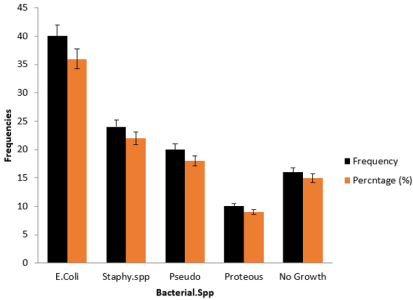Bacterial Survey of Diabetic Ulcers in Diabetic Patients in Hospitals at Aba, Nigeria
Introduction
Diabetes mellitus is one of the commonest diseases in tropical
areas. Diabetes mellitus may be described as a syndrome characterized
by hyperglycemia and disturbance of carbohydrate, fat and protein
metabolism resulting from defects in insulin secretion, insulin
action or both [1]. Aside complications like diabetic nephropathy,
neuropathy and retinopathy, diabetic ulcers are seen as the most
troubling problem in the hospitals and clinics [2]. Most times, it
involves the attention of both surgeon and internal physicians.
It has been reported that diabetic complications are associated
with overproduction of Reactive Oxygen Species (ROS) [3]. This
complication is considered the leading cause of death among these
patients. Oxidation plays a major role in diabetes [4]. The increase
in free radical release accompanied by decrease in antioxidants is a
major cause of diabetes [5]. In diabetes mellitus, there are usually
alterations in the endogenous free radical scavenging defenses
which leads to ineffective scavenging of reactive oxygen species
resulting to oxidative damage [6]. Experimental diabetes induced
by streptozotocin, selectively destroys the β-cells of pancreas by
generating excess reactive oxygen species and produces kidney
lesions that are similar to human diabetic nephropathy [7]. Studies
have shown that individuals with diabetes have a higher incidence
of kidney function abnormalities, as well as formation of free
radical due to glucose oxidation, non-enzymatic glycosylation of
proteins and subsequent oxidative degradation of glycated proteins,
leading to a decline in antioxidant defense mechanism and damage
of cellular organelles and enzymes and development of insulin
resistance which ultimately, culminate in renal complications
[8,9]. Thus, an early control of DM is recommended as one of main
strategy to prevent these complications and increase the life span
of these patients. Knowledge of the common pathogens associated
with diabetic ulcers may hasten quick recovery of the patients as
definitive therapy will be applied after confirmatory results of
wound swab culture.
Materials and Methods
A retrospective study of confirmed 110 diabetic patients with diabetic ulcers managed in different hospitals and clinics at Aba over 9 months were taken from the laboratory sections of the hospitals and clinics irrespective of their sexes and ages. Trauma related ulcers were ruled out. Specimens or wound swabs from different ulcers were taken before commencement of treatment under sterile conditions for microscopy, culture and sensitivity (MSC) at 300cincubation for 48 hours. The results of these ulcer and wound swabs were shown below. It should be noted that some of these patients had been on treatment either from patent medicine dealers or other clinics without records.
Ethical Consideration
Ethical approval was obtained from the State ministry of Health, Aba State; Nigeria. Consent from patient’s from whom data’s were obtained”.
Result
Bacterial survey of diabetic ulcers in diabetic patients (Figure 1) and (Table1).
Discussion
Aside complications like diabetic nephropathy, diabetic ulcers are seen as the most troubling problem in the hospital and clinics [2].Thus early control is recommended as one of the main strategy to prevent these complications. Diabetic ulcer if not checked leads to the destruction of body tissues and impair patient’s quality of life. Most diabetic ulcers can be prevented with good care and screening of people for risk factors [10]. It has also been implicated as one of the causes of Charot arthropathy [11,12], which involves progressive damage to the bones, joints and tissues of the body [12,13].
Therefore, the aim of this study was to carry out a bacterial survey of diabetic ulcers among diabetic patient in Aba, hospital in Abia State, Nigeria. Documented medical records of 110 confirmed diabetic patients admitted and managed in different hospitals and clinics at Aba were taken. Specimens or wound swabs were taken before commencement of treatment, though some patients would have being in several antibiotics without records. Our findings showed that Out of 110 diabetic patients with diabetic ulcers, specimens or wound swabs from these patients showed that 36.0% of cases were infected with Escherichia Coli, 22.0% cases with staphylococcus spp. This result also showed that 18.0% and 9.0% of cases were infected with pseudomonas spp and proteus spp respectively. Cultures of specimens or wound swabs of 15.0% of cases showed no significant growth. This indicated that these patients had being on several antibiotics in other places with no documentation or records.




No comments:
Post a Comment
Note: Only a member of this blog may post a comment.